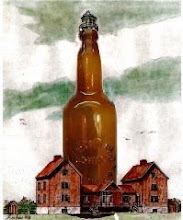Now that you have spent the entire growing season diligently caring for your vines, it is time to harvest what can turn out to be copious amounts of hops on healthy, mature plants. The following will cover some guidelines for you to follow in order to assure that you are harvesting your hops at their peak of potency and freshness. A little study in this area will allow you to accurately time your harvest so that you can maximize your return on your annual investment in water and time.
Take note, the following guidelines are on a cone by cone basis, rarely, if ever, will all of your cones be ready for harvest simply because some of them are presenting the signs that they are ready to harvest. Harvests can many times take days, or weeks to complete in separate stages for the home brewer. Hops farmers will often harvest everything at once, but at home you can take more care.
- Hop cones appear less “tight”, the leaves of the cone are visibly “opening”
- The bases of the hop leaves are showing ample amounts of bright yellow lupulin
- When squeezed, the cones emit the fragrant scent that you would come to expect from fresh hops (pungent, fragrant)
- When the cone is squeezed between your fingers and released, it feels papery, resilient, not green and hard
- The small bract leaves at the base of the hop stem are beginning to dry and the tips are browning
Typically when you observe a hop cone presenting all of the above traits, there will be an ample number just like it, enough to justify harvesting all of those that have peaked. Those cones that do not exhibit the signs listed above are best to be left alone until they do. It can take days or even weeks for them to mature.
Once you have harvested the ripe cones, it is time to prepare them for preservation. Hops have several enemies when it comes to maintaining their characteristics.
- Temperature
- Oxygen
- Time
Hops must be stored cool, or better yet frozen. The oils that exist in the lupulin glands are volatile and do not store well at room temperature. These oils are also easily oxidized, which means that long term storage planning must include some sort of vacuum packaging. Lastly, even if you have frozen and vacuum packaged your hops, time is one enemy that you cannot avoid, that is, unless you actively brew and use your hops!
To prepare your hops for storage as discussed above, they are typically dried. You can freeze them wet, or use them wet in a specialty beer if you like! There is a school of thought, however, that believes that freezing WET hops will actually serve to preserve the hops longer, though drying them is the norm. (Source Charlie Papazian, Homebrewers Companion)
To dry the hops you can use many methods, but stay away from cookie sheets and ovens if you can. Hops are fragile, their oils and thusly their characteristics are extremely susceptible to degradation from high temperatures, best to dry them slowly and naturally. Food dehydrators have been used with success, or another method that is used with great success is the box fan and window screen method.
If you have a home, you most certainly have windows, and you most certainly have some window screens to go along with them. You can use some chairs, 5 gallon buckets, really anything you can think of to support the window screen horizontally above the floor. Now, you must do the same with a cheap box fan from any retail store… supported above the floor (to allow it circulate air), but below your window screen, facing upward.
You can then spread your freshly harvested hops across the screen in a singular layer and turn the fan on low. You don’t want the hops flying all over your garage, but you do want to promote drying and air circulation. Agitate the hops periodically to ensure even drying of all of the hops. Allow this process to carry on until your leaf hops are papery and sufficiently dry to store. Once this is accomplished, vacuum seal and freeze any hops that you do not intend to use right away to preserve them.
When you are picking, make sure to keep the different varieties you grow in separate containers and drying screens as not to mix them up.



No comments:
Post a Comment